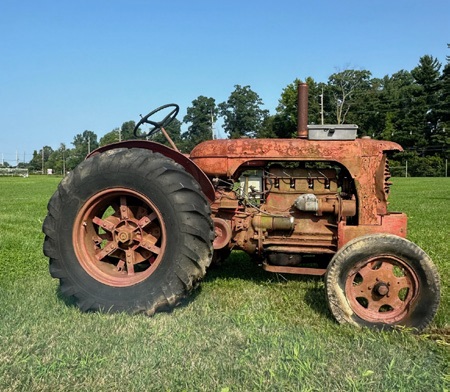by Gary Mount
 One basic of farming — especially as regarding farmers and their tractors — is that the more tractors a farmer has… the better life is.
One basic of farming — especially as regarding farmers and their tractors — is that the more tractors a farmer has… the better life is.
Keep in mind that the farmer’s spouse does not often share the “more tractor” idea as I learned some years ago when one of my brothers was here for Thanksgiving dinner. In between mouthfuls of turkey, he asked why we had 13 tractors. Dead silence followed, only to be broken by my wife Pam asking, “We have 13 tractors?”
The follow up to this story is that farmers rarely park their tractors in a row — too easy to count. But alas… sometimes the best plans go wrong, such as when Pam recently found a rusty old tractor in the weeds here at Terhune.
This beauty is a 1941 Case model SO. Its journey here is epic. It was purchased new by my father, and I spent many hours on it as I worked for my father while growing up. It was an exception in that
many farmers feel that not only are more tractors better, but bigger ones are better.
The Case SO was the reverse. Orchardists such as my father needed smaller and narrower tractors to fit between the tree rows. Terhune matches this because most of our tractors are of the smaller, narrower type — after all, grape rows are 9 feet apart, blueberries are 10 feet apart, and our most recently-planted apples are 12 feet apart.
The end of that story is that although the bigger tractors are more comfortable and can cover acreage more rapidly, it just depends on the crop being grown. Or it might just depend on who the farmer is!
My farmer friend Harry Schaafsma lived on Cold Soil Road near us (we say near but Harry and his wife Margaret had such a long driveway they actually lived in the next township). Harry used his tractor as a base for a post to support a sagging shed roof. That was his tractor’s last job and it stayed there year after year.
But back to the Case model SO. It had been purchased from our family by Mr. LaPlaca, a Princeton business owner (Nassau Interiors) who also owned a property near my father’s farm. I have no idea why he purchased it because he was not a farmer but I saw it in the weeds along Route One shortly after Pam and I purchased Terhune in 1975. I had to have it.
It no longer ran but I got it transported home and with a lot of love the Case ran again. Unfortunately, it did not quite run well enough to be useful to me here at Terhune.
I have always dreamed of restoring the Case, but somehow, I’m always too busy. The future of the Case will be determined by the strength of my resolve to get it out of the weeds and into the farm shop for rehab this coming winter.
It will be a long way from where it was built in Racine, Wisconsin and it will not have a cab like the one my father installed to shelter the driver while spraying (all tractors that are used for such purpose at Terhune have sealed cabs and air conditioning) but the Case will follow a family tradition.
My grandfather, who also farmed the same farm in West Windsor was a tractor dealer of early tractors made by the Avery tractor company in Louisville, Kentucky.
These steel wheeled behemoths arrived by rail in Trenton and were delivered by my father and his brothers by driving over the roads. They ran on kerosene (sometimes called coal oil) but Avery was a tractor brand that went out of business early.
Our farm switched to Case tractors which became the only brand to have (most farmers are very loyal to their brand of tractor but at Terhune we are eclectic). We have John Deere-green, Kubota- orange, and Deutz-green.
For me it is a matter of mileage to the dealer and that dealer’s service record. One thing for sure is that tractors always need repair. It will be a challenge to find parts that might be needed this winter for the Case SO but fortunately we now have the Internet. Wish me luck!
